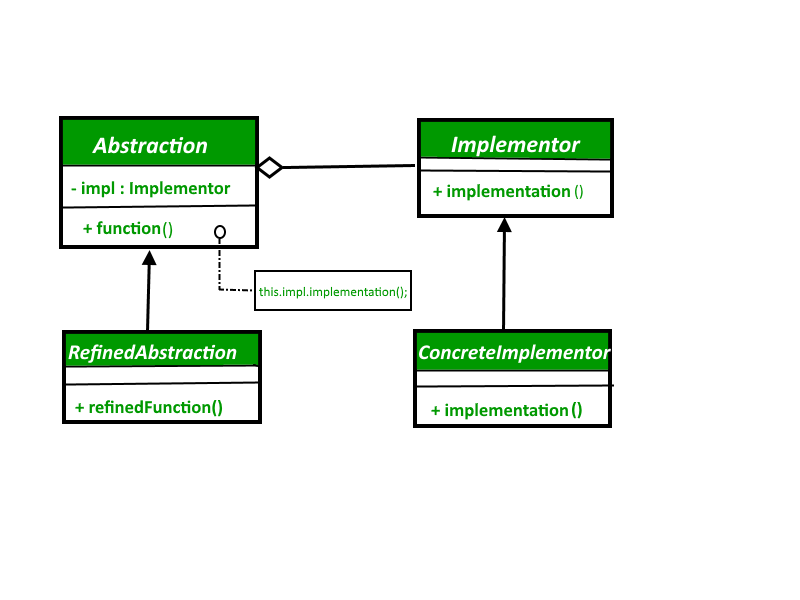The Bridge design pattern allows you to separate the abstraction from the implementation. It is a structural design pattern.
There are 2 parts in Bridge design pattern :
- Abstraction
- Implementation
This is a design mechanism that encapsulates an implementation class inside of an interface class.
- The bridge pattern allows the Abstraction and the Implementation to be developed independently and the client code can access only the Abstraction part without being concerned about the Implementation part.
- The abstraction is an interface or abstract class and the implementer is also an interface or abstract class.
- The abstraction contains a reference to the implementer. Children of the abstraction are referred to as refined abstractions, and children of the implementer are concrete implementers. Since we can change the reference to the implementer in the abstraction, we are able to change the abstraction’s implementer at run-time. Changes to the implementer do not affect client code.
- It increases the loose coupling between class abstraction and it’s implementation.
UML Diagram of Bridge Design Pattern

Example:
namespace RefactoringGuru\Bridge\Conceptual;
/**
* The Abstraction defines the interface for the "control" part of the two class
* hierarchies. It maintains a reference to an object of the Implementation
* hierarchy and delegates all of the real work to this object.
*/
class Abstraction
{
/**
* @var Implementation
*/
protected $implementation;
public function __construct(Implementation $implementation)
{
$this->implementation = $implementation;
}
public function operation(): string
{
return "Abstraction: Base operation with:\n" .
$this->implementation->operationImplementation();
}
}
/**
* You can extend the Abstraction without changing the Implementation classes.
*/
class ExtendedAbstraction extends Abstraction
{
public function operation(): string
{
return "ExtendedAbstraction: Extended operation with:\n" .
$this->implementation->operationImplementation();
}
}
/**
* The Implementation defines the interface for all implementation classes. It
* doesn't have to match the Abstraction's interface. In fact, the two
* interfaces can be entirely different. Typically the Implementation interface
* provides only primitive operations, while the Abstraction defines higher-
* level operations based on those primitives.
*/
interface Implementation
{
public function operationImplementation(): string;
}
/**
* Each Concrete Implementation corresponds to a specific platform and
* implements the Implementation interface using that platform's API.
*/
class ConcreteImplementationA implements Implementation
{
public function operationImplementation(): string
{
return "ConcreteImplementationA: Here's the result on the platform A.\n";
}
}
class ConcreteImplementationB implements Implementation
{
public function operationImplementation(): string
{
return "ConcreteImplementationB: Here's the result on the platform B.\n";
}
}
/**
* Except for the initialization phase, where an Abstraction object gets linked
* with a specific Implementation object, the client code should only depend on
* the Abstraction class. This way the client code can support any abstraction-
* implementation combination.
*/
function clientCode(Abstraction $abstraction)
{
// ...
echo $abstraction->operation();
// ...
}
/**
* The client code should be able to work with any pre-configured abstraction-
* implementation combination.
*/
$implementation = new ConcreteImplementationA();
$abstraction = new Abstraction($implementation);
clientCode($abstraction);
echo "\n";
$implementation = new ConcreteImplementationB();
$abstraction = new ExtendedAbstraction($implementation);
clientCode($abstraction);
